There are many ways to brew a great cup of coffee, but for many Vietnamese, the moment spent waiting for each drop to fall from the phin filter has become a deeply rooted cultural ritual. Learning how to make Vietnamese coffee at home takes not only careful selection of the beans but also meticulous attention to every step of the Vietnamese coffee making process.
How is Vietnamese coffee made?
Vietnamese coffee stands out from many other coffee traditions thanks to its bold flavors and distinctive brewing style. Understanding how Vietnamese coffee is made begins with recognizing a key difference: the use of Robusta beans, which naturally have a higher caffeine content and a stronger, more bitter profile compared to the Arabica beans preferred in many other countries. This gives Vietnamese coffee at home its signature intensity and full-bodied taste.
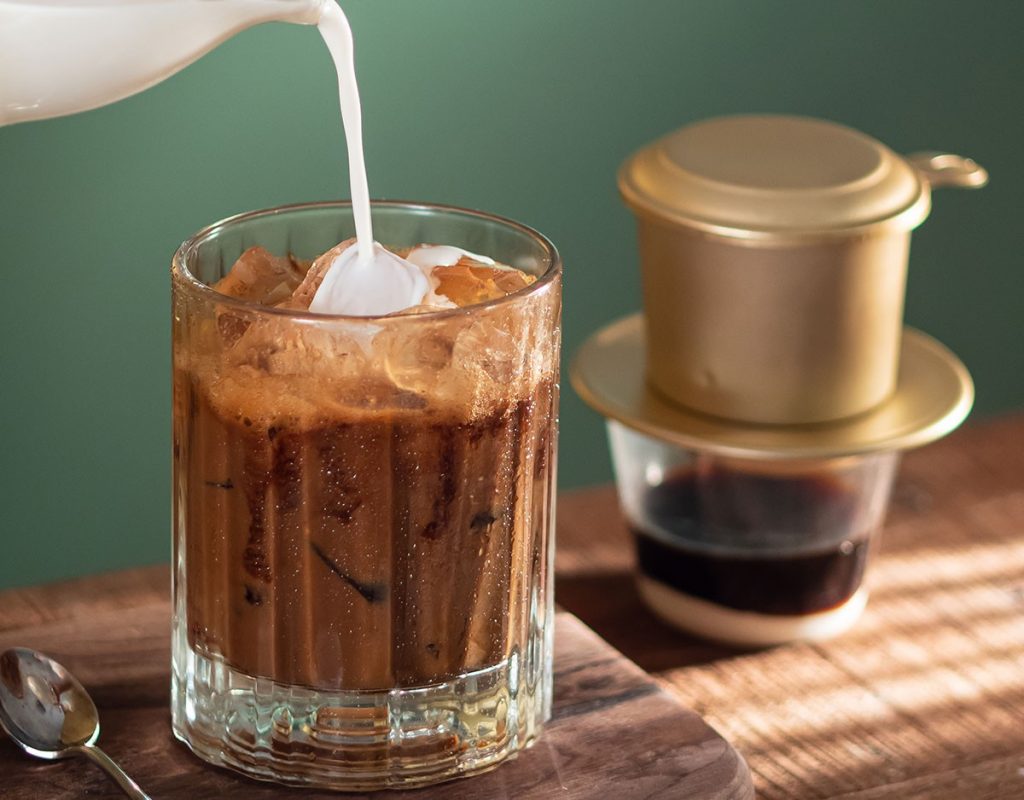
The Vietnamese coffee making method is also unique. Instead of modern espresso machines, Vietnamese coffee is often prepared using a phin filter — a small, perforated metal drip filter that allows hot water to slowly pass through the coffee grounds. This slow extraction process, which can take several minutes, produces a rich, concentrated brew with deep aromas when you learn how to make Vietnamese coffee.
Beyond the brewing style, Vietnamese people are known for their creativity in transforming coffee into a variety of drinks. From the classic cà phê sữa đá (iced coffee with condensed milk) to cà phê trứng (egg coffee), cà phê dừa (coconut coffee), and even cà phê muối (salt coffee), each Vietnamese coffee recipe adds a unique twist while keeping the strong, robust base that defines Vietnamese coffee culture.
Types of Vietnamese coffee
Vietnamese coffee comes in many unique variations, each with its own flavor and preparation style.
Vietnamese drip coffee (Cà phê Phin)
The cornerstone of Vietnamese coffee culture, brewed using a traditional metal drip filter. Ground Robusta coffee is placed in the phin, hot water is poured over, and coffee slowly drips through. Served hot or iced, typically with sweetened condensed milk. Brewing time: 5-7 minutes. Creates a strong, concentrated hot Vietnamese coffee with earthy, slightly bitter notes.
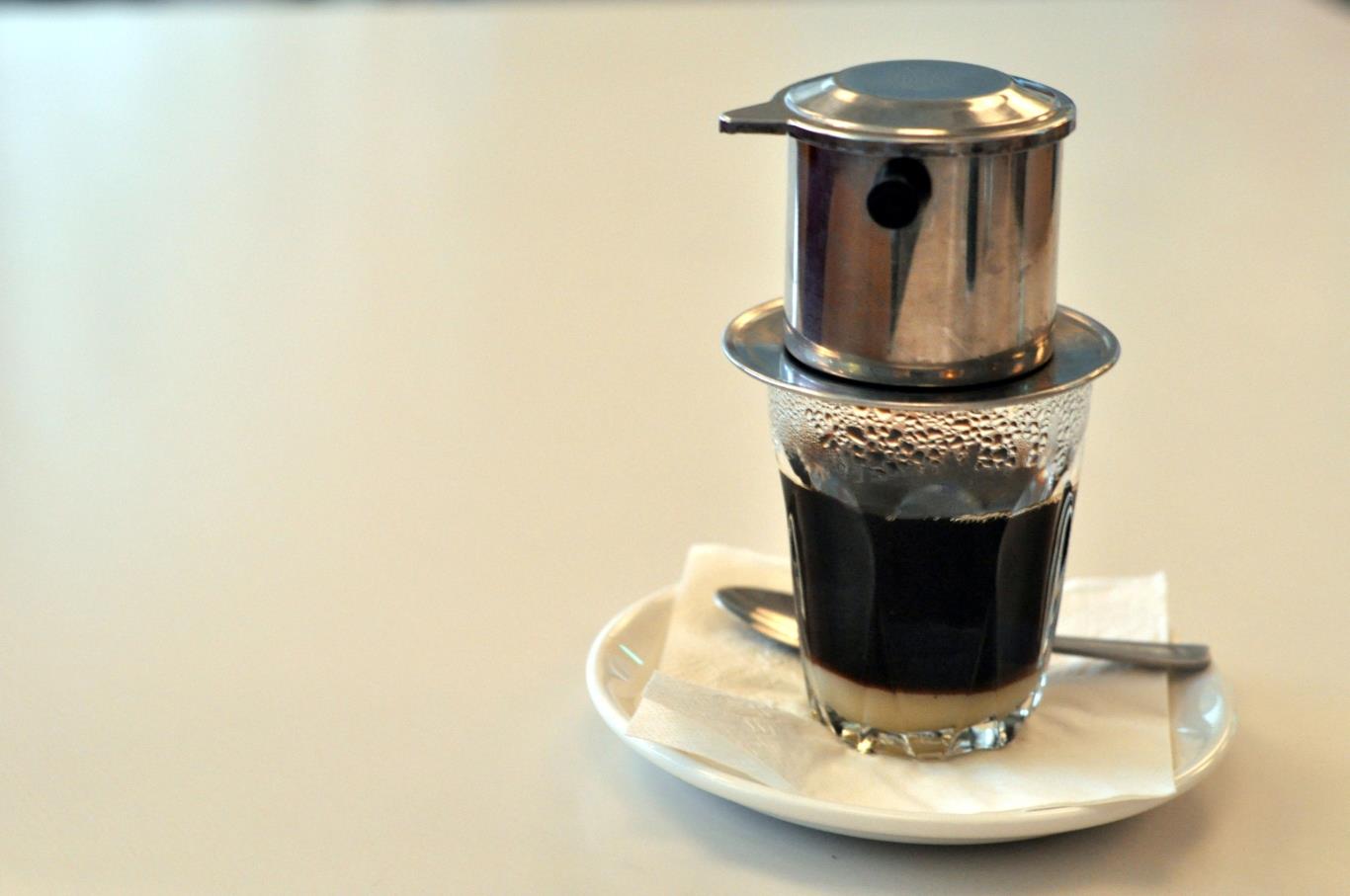
Iced coffee with condensed milk (Cà phê sữa đá)
Vietnam’s most famous coffee export. Strong phin-brewed coffee combined with 2-3 tablespoons of sweetened condensed milk, poured over ice. The condensed milk adds richness and balances the coffee’s intensity. Often served in a tall glass with a distinctive layer separation before stirring.

Salt coffee (Cà phê muối)
Originated in Huế, central Vietnam. A small pinch of sea salt (about 1/8 teaspoon) is added to regular Vietnamese coffee recipe preparation. The salt enhances natural sweetness, reduces bitterness, and creates a unique savory-sweet flavor profile. Can be served hot or iced, often topped with salted foam similar to salted caramel drinks.

Coconut coffee (Cà phê dừa)
Popular in southern Vietnam’s Mekong Delta region. Fresh coconut milk or coconut cream replaces condensed milk as the creamer. Provides natural sweetness with tropical coconut flavor. Often garnished with toasted coconut flakes or served in actual coconut shells. Dairy-free alternative that’s lighter than traditional versions.

There are also some other famous Vietnamese coffee variations such as:
- Egg coffee (Cà phê trứng): Hanoi specialty with whipped egg yolk foam topping
- Bac xiu coffee: Higher milk-to-coffee ratio, milder and sweeter than “sữa đá”
- Black coffee (Cà phê đen): Pure coffee without additives, showcasing Robusta’s bold flavor
How to make traditional Vietnamese Phin coffee
Unlike espresso machines that work in seconds, the phin allows hot water to gently drip through the coffee grounds, creating a concentrated and aromatic cup when you learn Vietnam coffee how to make.
Vietnamese Phin coffee ingredients
Understanding the correct Vietnamese coffee ingredients and Vietnamese coffee measurements is crucial for authentic results:
- Coffee beans or ground coffee: Freshly roasted and ground coffee beans, usually a blend of Robusta or Arabica, depending on personal preference
- Phin filter: A Vietnamese aluminum or stainless steel phin filter, commonly used in Vietnam
- Boiling water: Pure water boiled to a temperature of approximately 95-100°C
- Coffee cup or glass: A glass cup is ideal to observe the coffee dripping process
Vietnamese coffee ratio and measurements
The perfect Vietnamese coffee ratio is essential for authentic taste:
- Coffee amount: 20-25 grams (3-4 teaspoons) for Vietnamese coffee measurements
- Water amount: 80-100ml total
- First pour: 20ml for blooming
- Second pour: 60-80ml for main extraction
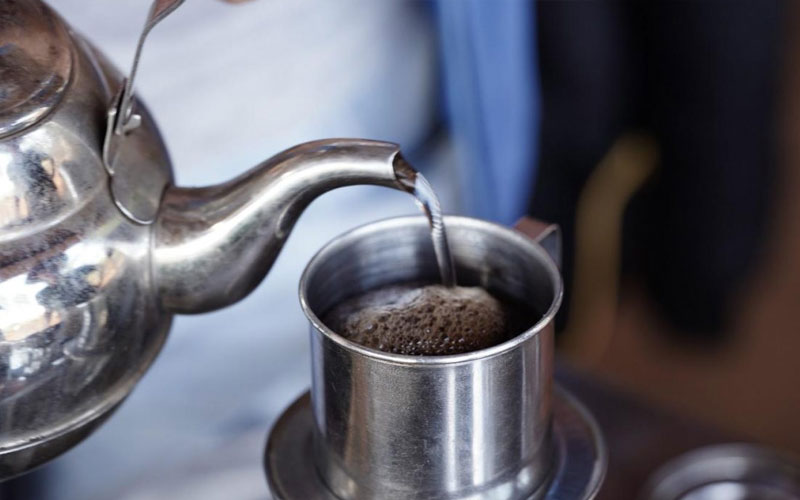
Step-by-step Vietnamese Phin coffee recipe instructions
Step 1: Choose your coffee
Select your favorite coffee type, typically Robusta for its strong and bold flavor or Arabica for its mild aroma. Ensure that the coffee is freshly ground to preserve the best flavor for your Vietnamese coffee at home.
Step 2: Prepare the phin filter
- Clean the phin: Before brewing, rinse the phin with hot water to warm up the filter and the cup. This helps the coffee bloom evenly and maintain heat better during the Vietnamese coffee making process.
- Measure the coffee: Add about 20-25 grams of coffee (equivalent to 3-4 teaspoons) into the phin using proper Vietnamese coffee measurements. Use the press to lightly level the coffee grounds.
Step 3: Pour the boiling water
Following the correct Vietnamese coffee ratio:
- First pour: Pour a small amount of boiling water (about 20ml) over the coffee grounds to allow the coffee to bloom for about 30 seconds.
- Second pour: Continue pouring an additional 60-80ml of boiling water into the phin. Cover with the lid and wait for the coffee to drip.
Step 4: Enjoy your coffee
The coffee will slowly and steadily drip into the cup, creating a rich, aromatic brew. The Vietnamese coffee making process takes about 5-7 minutes. Once the coffee has finished dripping, you can add sugar, condensed milk, or ice according to your Vietnamese coffee recipe preference.
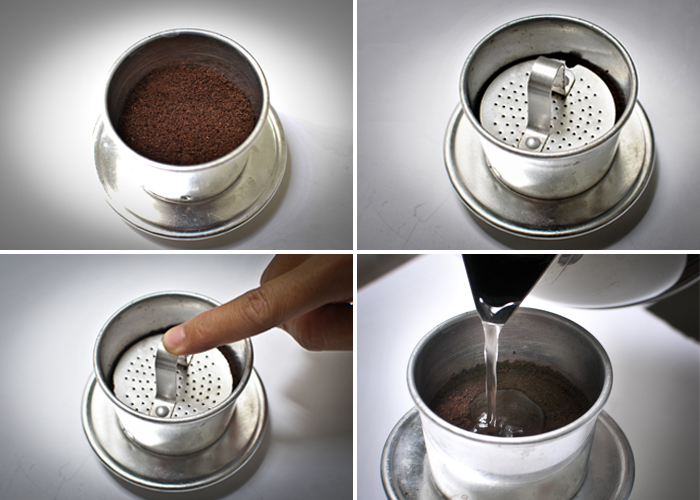
Tips for better Vietnamese Phin coffee at home
- Water quality: Pure water helps the coffee retain its original flavor when making Vietnamese coffee at home
- Coffee amount: Adjust how much coffee for Vietnamese coffee and water to achieve your desired strength
- Water temperature: Avoid using water that is too hot, as it can burn the coffee and negatively affect the flavor
How to make Vietnamese iced coffee with condensed milk
Vietnamese coffee ingredients for iced version
Essential Vietnam coffee ingredients for the classic iced version:
- Coffee beans or ground coffee: Freshly roasted coffee, typically Robusta for a strong, bold taste, or a blend of Robusta and Arabica for balanced flavor
- Phin filter: A traditional Vietnamese aluminum or stainless steel phin filter
- Condensed milk: Sweetened condensed milk, which gives the coffee its creamy texture and signature sweetness
- Boiling water: Pure water heated to approximately 95–100°C
- Glass with ice: A tall glass filled with clean, fresh ice cubes
Step-by-step Vietnamese iced milk coffee recipe instructions
Step 1: Prepare the coffee
Choose your preferred coffee type and grind it medium-coarse. Place about 20–25 grams (3–4 teaspoons) of ground coffee into the phin following proper Vietnamese coffee measurements. Use the press to gently level the coffee grounds.
Step 2: Bloom the coffee
Pour a small amount of boiling water (about 20ml) over the coffee grounds to let them bloom for 30 seconds. This releases the aroma and ensures even extraction in your Vietnamese coffee making process.
Step 3: Brew the coffee
Add the rest of the boiling water (60–80ml) into the phin using the correct Vietnamese coffee ratio. Cover with the lid and allow the coffee to drip slowly into a cup that already contains 2–3 tablespoons of sweetened condensed milk. The Vietnam coffee making process takes about 5–7 minutes.
Step 4: Mix and serve
Once the coffee has finished dripping, stir well to combine it with the condensed milk. Pour the Vietnamese coffee mix into a tall glass filled with ice cubes. Enjoy the refreshing blend of strong coffee, creamy milk, and cool ice.
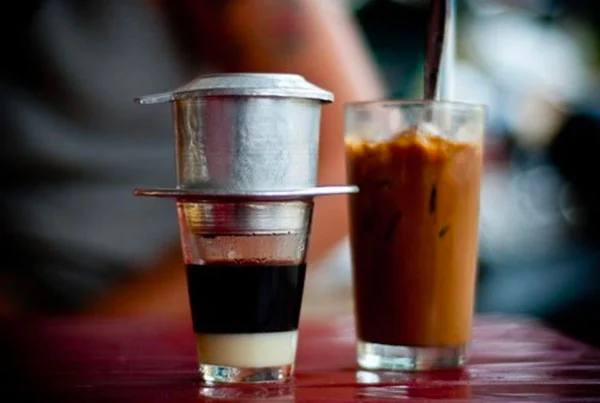
Tips for the perfect Vietnamese iced coffee
- Adjust sweetness: Vary the amount of condensed milk depending on how sweet you like your Vietnamese coffee at home
- Fresh coffee is key: Use freshly roasted and ground coffee for the best Vietnamese coffee recipe
- Steady drip: If the coffee drips too quickly, the grind may be too coarse; too slowly, and it may be too fine
How to make Vietnamese salt coffee
To make salted coffee, you need to brew black coffee (filter or instant coffee) and then combine it with salted cream. Ice cream is made from heavy cream, fresh milk (or condensed milk), and a little salt, whipped up. Finally, pour coffee into the glass, add ice, then add cream on top.
Vietnamese coffee ingredients for salt coffee
Key Vietnamese coffee ingredients for this unique variation:
- Vietnamese ground coffee: About 20 g (2–3 teaspoons), preferably Robusta for a strong and bold flavor
- Condensed milk: Adds sweetness and creaminess to balance the coffee’s strength
- Salt: A small pinch (about ⅛ teaspoon) to enhance sweetness and reduce bitterness
- Heavy cream or fresh milk: For a smooth, slightly salty cream layer; whipped cream can also be used
- Boiling water: Around 95–100 °C for proper extraction
- Phin filter: A traditional Vietnamese metal drip filter
Step-by-step Vietnamese salt coffee recipe instructions
Step 1: Brew the coffee
Rinse the phin filter with hot water to warm it up. Add ground coffee using proper Vietnamese coffee measurements, press lightly to level the surface, and place the phin over your cup. Pour a small amount of boiling water (about 20ml) to let the coffee bloom for 30 seconds, then add the remaining water (60–80ml) following the Vietnamese coffee ratio and cover with the lid. Let it drip slowly for about 4–5 minutes.
Step 2: Prepare the salted cream mixture
In a small bowl, mix condensed milk, a small pinch of salt, and heavy cream or fresh milk. Stir gently until smooth; lightly whip if using cream to create a soft, frothy texture for your Vietnamese coffee mix.
Step 3: Assemble the drink
Pour the salted cream mixture into your cup first. Once the coffee finishes dripping, slowly pour it over the cream. You can stir lightly or leave the layers separate for visual appeal.
Step 4: Serve and enjoy
Vietnamese salt coffee can be served hot or over ice. The light saltiness enhances the sweetness of the milk and highlights the natural bitterness of the coffee, creating a rich and unique flavor experience.

Tips for the best Vietnamese salt coffee
- Use only a tiny pinch of salt to avoid overpowering the drink when making Vietnamese coffee at home
- Robusta coffee is ideal for a deeper, bolder flavor in your Vietnamese coffee recipe
- Try adding a drop of vanilla extract for extra aroma
How to make Vietnamese coconut coffee
Coconut coffee is usually prepared by combining coffee (usually filter coffee or espresso) with condensed milk, coconut milk and ice. Some variations also add other ingredients such as fresh milk, coconut cream, or shredded coconut to add flavor and richness.
Vietnamese coffee ingredients for coconut coffee
Essential Vietnam coffee ingredients for this tropical variation:
- Vietnamese ground coffee: About 20 g (2–3 teaspoons), preferably Robusta or a Robusta–Arabica blend for a strong, balanced flavor
- Condensed milk: 2–3 tablespoons for sweetness and creaminess
- Coconut milk or coconut cream: 50–70 ml for a rich, tropical taste
- Ice cubes: Fresh, clean ice for serving
- Boiling water: Around 95–100 °C for brewing
- Phin filter: A traditional Vietnamese metal drip filter
- Optional: Shredded coconut or cocoa powder for garnish
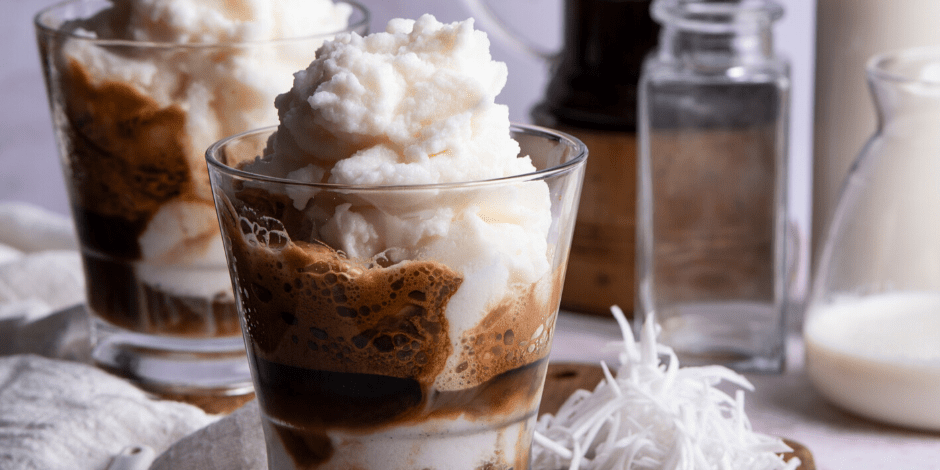
Step-by-step Vietnamese coconut coffee recipe instructions
Step 1: Brew the coffee
Rinse the phin filter with hot water to warm it up. Add ground coffee using correct Vietnamese coffee measurements, press lightly, and place the phin over your cup. Pour about 20 ml of boiling water to let the coffee bloom for 30 seconds, then add the remaining water (60–80 ml) following the proper Vietnamese coffee ratio and cover with the lid. Let it drip for 4–5 minutes.
Step 2: Prepare the coconut mixture
In a blender, combine condensed milk, coconut milk or coconut cream, and a handful of ice cubes. Blend until smooth, creamy, and slightly frothy to create the perfect Vietnamese coffee mix.
Step 3: Assemble the drink
Fill a tall glass with ice cubes. Pour the brewed coffee into the glass, then slowly add the blended coconut mixture on top.
Step 4: Serve and enjoy
Stir gently before drinking to combine the coffee with the coconut cream. You’ll get a delightful balance of strong coffee, creamy sweetness, and tropical aroma in your Vietnamese coffee at home.
Tips for the best Vietnamese coconut coffee
- Use full-fat coconut milk or coconut cream for a richer flavor in your Vietnamese coffee recipe
- Adjust the amount of condensed milk to suit your sweetness preference
- Brew with strong Robusta coffee to ensure the coffee flavor stands out against the creaminess
What coffee to use to make standard Vietnamese coffee?
Hello 5 Coffee brings you the true essence of Vietnamese coffee culture with carefully selected beans and traditional roasting methods. Using premium Robusta and Arabica blends sourced from the best coffee regions in Vietnam, Hello 5 Coffee offers a bold, aromatic cup that perfectly balances intensity and smoothness for your Vietnamese coffee at home.

Whether you enjoy the classic deep flavor of our Hello 5 Coffee Original, the vibrant notes of Hello 5 Coffee Mondo, or the rich complexity of Hello 5 Coffee Deluxe, each blend is crafted to deliver an unforgettable Vietnamese coffee experience.
Our coffee is specially designed to work perfectly with the traditional Vietnamese phin filter, ensuring a slow, flavorful extraction that highlights every layer of aroma and taste when you learn how to make Vietnamese coffee.
For those who love to experiment, Hello 5 Coffee is also ideal for making popular Vietnamese specialties such as cà phê sữa đá (iced coffee with condensed milk), cà phê dừa (coconut coffee), and even cà phê muối (salt coffee) using our proven Vietnamese coffee recipe methods.
With Hello 5 Coffee, you’re not just drinking coffee—you’re savoring a cultural heritage in every cup. Experience the boldness, richness, and authenticity of Vietnamese coffee wherever you are with our premium Vietnam coffee ingredients.
This comprehensive guide has shown you how to make Vietnamese coffee and popular Vietnamese coffee drinks while understanding their special flavors. We hope this Vietnamese coffee recipe collection inspires you to try making these delicious drinks at home and explore the bold flavors of Vietnam’s coffee culture. Whether you’re preparing hot Vietnamese coffee or experimenting with different Vietnamese coffee ingredients, mastering Vietnam coffee making techniques will help you create authentic flavors. Wishing you many enjoyable moments savoring every cup of your homemade Vietnamese coffee at home!
